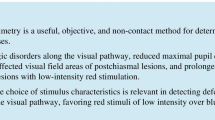Abstract
Purpose
Positron emission tomography (PET), the blood flow response in the primary visual cortex (V1) to two visual stimuli, low temporal frequency (6 Hz) to activate the parvocellular system, and high temporal frequency (25 Hz) to activate the magnocellular system were used to investigate pathophysiologic mechanism of amblyopia.
Methods
Five women and one man who were aged between 26 and 60 years, who were ophthalmologically normal except for amblyopia, and who had corrected visual acuity in the amblyopic eye of 0.6 or worse were examined. An intravenous injection of the H215O was given, and the regional cerebral blood flow was measured by PET during full-field stimulation with either 6 Hz or 25 Hz flicker to the amblyopic or the sound eye.
Result
The activation of blood flow in the contra-lateral area V1 by the 6-Hz stimulation of the sound eye was greater than that during the stimulation of the amblyopic eye (P<0.05, small volume correction, n=6). With 25-Hz stimulation of the sound and amblyopic eyes, the blood flow in the contra-lateral and ipsi-lateral areas V1 was not significantly different.
Conclusion
The decreased activation of blood flow in the contra-lateral V1 by low temporal frequency stimuli supports the hypothesis that the parvocellular pathway in amblyopic eyes is depressed.




Similar content being viewed by others
References
Barnes GR, Hess RF, Dumoulin SO, et al (2001) The cortical deficit in humans with strabismic amblyopia. J Physiol (Lond) 533:281–297
Campos E (1995) Amblyopia. Surv Ophthalmol 40:23–39
Choi MY, Lee KM, Hwang JM, et al (2001) Comparison between anisometropic and strabismic amblyopia using functional magnetic resonance imaging. Br J Ophthalmol 85:1052–1056
Choi MY, Lee DS, Hwang JM, et al (2002) Characteristics of glucose metabolism in the visual cortex of amblyopes using positron-emission tomography and statistical parametric mapping. J Pediatr Ophthalmol Strabismus 39:11–19
Daw NW (1995) Visual development. Plenum, New York
Demer JL (1993) Positron emission tomographic studies of cortical function in human amblyopia. Neurosci Biobehav Rev 17:469–476
Demer JL, Noorden GK von, Volkow ND, et al (1988) Imaging of cerebral blood flow and metabolism in amblyopia by positron emission tomography. Am J Ophthalmol 105:337–347
Demer JL, Grafton S, Marg E (1997) Positron-emission tomographic study of human amblyopia with use of defined visual stimuli. J AAPOS 1:158–171
Demirci H, Gezer A, Sezen F, et al (2002) Evaluation of the functions of the parvocellular and magnocellular pathways in strabismic amblyopia. J Pediatr Ophthalmol Strabismus 39:215–221
Friston KJ, Frith CD, Liddle PF, et al (1990) The relationship between global and local changes in PET scans. J Cereb Blood Flow Metab 10:458–466
Goodyear BG, Nicolle DA, Humphrey GK, et al (2000) BOLD fMRI response of early visual areas to perceived contrast in human amblyopia. J Neurophysiol 84:1907–1913
Grigg J, Thomas R, Billson F (1996) Neuronal basis of amblyopia: a review. Ind J Ophthalmol 44:69–76
Herscovitch P, Raichle ME, Kilbourn MR, et al (1987) Positron emission tomographic measurement of cerebral blood flow and permeability-surface area product of water using [15O]water and [11C]butanol. J Cereb Blood Flow Metab 7:527–542
Horton JC, Hoyt WF (1991) The representation of the visual field in human striate cortex. A revision of the classic Holmes map. Arch Ophthalmol 6:816–824
Hubel DH, Wiesel TN (1970) The period of susceptibility to the physiological effects of unilateral eye closure in kittens. J Physiol (Lond) 206:419–436
Hubel DH, Wiesel TN, LeVay S (1977) Plasticity of ocular dominance columns in monkey striate cortex. Philos Trans R Soc Lond Biol 278:377–409
Imamura K, Richter H, Fischer H, et al (1997) Reduced activity in the extrastriate visual cortex of individuals with strabismic amblyopia. Neurosci Lett 225:173–176
Kabasakal L, Devranoglu K, Arslan O, et al (1995) Brain SPECT evaluation of the visual cortex in amblyopia. J Nucl Med 36:1170–1174
Kawasaki T, Kiyosawa M, Ishii K, et al (1998) Regional cerebral blood flow response to visual stimulation measured quantitatively with PET. Neuro-Ophthalmology 20:79–89
Lee KM, Lee SH, Kim NY, et al (2001) Binocularity and spatial frequency dependence of calcarine activation in two types of amblyopia. Neurosci Res 40:147–153
Miki A, Liu GT, Raz J, et al (2000) Contralateral monocular dominance in anterior visual cortex confirmed by functional magnetic resonance imaging. Am J Ophthalmol 130:821–824
Miki A, Liu GT, Englander SA, et al (2001) Functional magnetic resonance imaging of eye dominance at 4 Tesla. Ophthalmic Res 33:276–282
Noorden GK von, Middleditch PR (1975) Histology of the monkey lateral geniculate nucleus after unilateral lid closure and experimental strabismus: further observations. Invest Ophthalmol 14:674–683
Noorden GK von, Crawford ML, Levacy RA (1983) The lateral geniculate nucleus in human anisometropic amblyopia. Invest Ophthalmol Vis Sci 24:788–790
Mizoguchi S, Suzuki Y, Kiyosawa M, et al (2003) Detection of visual activation of lateral geniculate nucleus by positron emission tomography. Graefes Arch Clin Exp Ophthalmol 241:8–12
Schiller PH, Logothetis NK (1990) The color-opponent and broad-band channels of the primate visual system. Trends Neurosci 13:392–398
Shan Y, Moster ML, Roemer RA, et al (2000) Abnormal function of the parvocellular visual system in anisometropic amblyopia. J Pediatr Ophthalmol Strabismus 37:73–78
Worsley KJ, Marrett S, Neelin P, et al (1996) A unified statistical approach for determining significant signals in images of cerebral activation. Hum Brain Mapp 4:58–73
Worsley KJ, Andermann M, Koulis T, et al (1999) Detecting changes in nonisotropic images. Hum Brain Mapp 8:98–101
Author information
Authors and Affiliations
Corresponding author
Rights and permissions
About this article
Cite this article
Mizoguchi, S., Suzuki, Y., Kiyosawa, M. et al. Differential activation of cerebral blood flow by stimulating amblyopic and fellow eye. Graefe's Arch Clin Exp Ophthalmol 243, 576–582 (2005). https://doi.org/10.1007/s00417-004-1009-5
Received:
Accepted:
Published:
Issue Date:
DOI: https://doi.org/10.1007/s00417-004-1009-5




